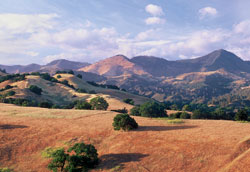This Place on Earth
A brief path through the woods leads to an open, sun-drenched field full of wildflowers. Past a tumble-down stone wall, more woods, and paths, await. Beyond the fields’ perimeters are the palatial homes that inhabit this well-to-do section of Fairfield, Connecticut—groomed lawns stretching like golf courses; manicured bushes like so many puffs of a poodle’s tail. Even on the preserved paths of this section of the Aspetuck Land Trust, one can hear the rush of highway traffic just ahead. But in an area of the country given to giant homes and crowded condo complexes, these 14 acres of woods, wetlands and fields are preserved because in the 1980s their former owner, Ernest Tillman, thought they were worth saving. “We preserve land for three primary reasons,” says Aspetuck Land Trust Executive Director Bruce LePage, “for passive recreation, for habitat and to preserve rural characteristics and scenic views.”

In total, the Aspetuck Land Trust is protecting 1,700 acres of Connecticut land from future development.
“For a flat-out donation, there’s a very good tax allowance,” says Culver Modisette, the president of the Northern Connecticut Land Trust.
Groomed trails open to the public are one indication that land has been donated outright to a nonprofit land trust, or bought by the land trust through federal and private donations. Many more land owners will opt for “conservation easements,” in which owners transfer any future development rights to a land trust but are able to keep the property private. Terms of the agreement vary considerably. A certain number of homes may be allowed on site, and larger parcels can be subdivided and sold separately, in which case the easement applies to all the smaller lots. Farmers may continue to farm the land, and hunting or other activities may be allowed.
The owner receives the percentage of the appraised value of the land equal to the cost of the development rights (from 40 to 60 percent), either in cash or tax deductions, and keeps the property. The land trust sends monitors once or twice a year. In either case, the land is preserved in perpetuity and the agreement is binding on future owners.
Resisting Developers

When the value of land soars, the landowner faces huge tax burdens and is pressured to sell to developers. By donating his or her land to a land trust, the owner realizes a state and federal income tax deduction and significant property and estate tax savings. That’s particularly useful to farmers and ranchers who are unable to bear the cost of their land as nearby lots get turned into high-value housing.
“In Santa Barbara and coastal California, people are buying rural land at prices that don’t make sense if it was intended for agriculture,” says Michael Feeney, executive director of the Land Trust for Santa Barbara County. “Conservation easements are a way for landowners to get equity without selling, subdividing or giving up the resource value they appreciate.”
The conservation tax incentive in place over the past year, set to expire in December, targets those middle-income land owners by raising the maximum deduction donors can take from 30 to 50 percent of their yearly income. This allows donors to deduct up to 100 percent of their income and extend the tax deductions from the original five to 15 years. The nonprofit Land Trust Alliance is working to make the incentive permanent.
The number of acres protected under land trusts doubled between 2001 and 2005, to 37 million acres. A plethora of new trusts are forming—there are now 1,667 in the U.S. “We aren’t trying to stop development,” says Modisette, “but you can be intelligent about it.”

